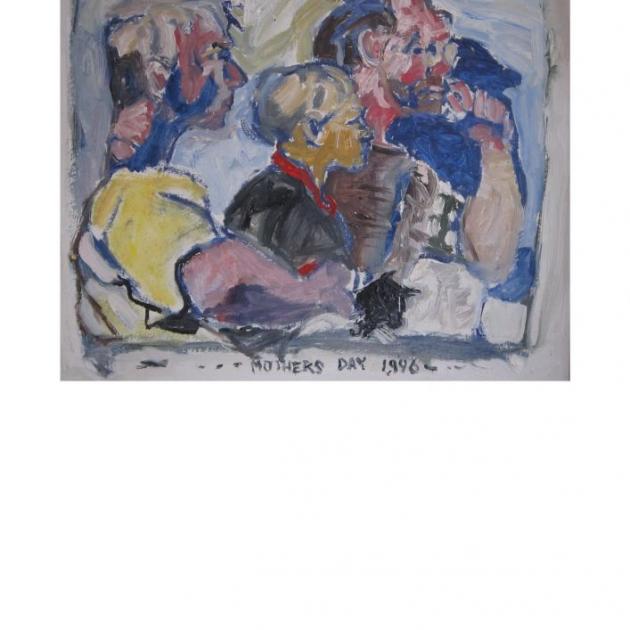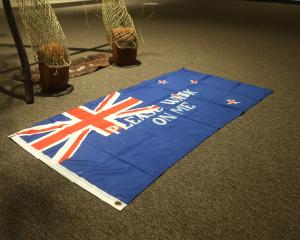
''Away and Towards,'' Nigel Brown (Milford Galleries Dunedin)
Milford Galleries Dunedin's latest show crowds its walls with 34 works by renowned painter Nigel Brown.
The paintings, spanning 33 years of the artist's practice, become by default a sort of survey or retrospective.
However, the show does not rely on this facade and instead proves to be a bold statement about the artist's prolific and ongoing exploration of New Zealand history and society.
Across the works, the visitor will find a plethora of references from Maori traditions, religious symbols, native birds, colonialism, kiwiana and New Zealand and European art history.
There is a particular enjoyment to be had in perusing the works and being familiar with what is distinctly New Zealand.
Glass Wall, one of the largest works in the exhibition, proves to be a culmination of many of the themes found across the show.
Creating a patchwork of figures and objects related distinctly to New Zealand, Brown shows the dispersion of New Zealand culture and the many disjointed facets that make up our national identity.
Aside from his paintings' narratives, this collection of works prove Brown's enduring mastery of the paint medium and unwavering thoughtful and dynamic compositions.
There is a sense of Brown building up the work upon the canvas to reach his conceptual intent for each piece.
The exhibition does not play up any chronological ordering of the works, and while a type of linear development can be realised through looking at Brown's practice across time, the salient impression is of his persistent consideration of who we are and where we have come from and how this history is directing our future.

''Campaign Furniture,'' Juliet Carpenter, Sorawit Songsataya and Biljana Popovic (Dunedin Public Art Gallery)
Henry Davidson finishes his stint as the 2013-2014 Creative New Zealand curatorial intern in contemporary art with the exhibition ''Campaign Furniture''.
Curated by Davidson and featuring three young Auckland-based artists, the show is undeniably fresh-faced and provides a glimpse into the future of New Zealand art.
The show takes the Dunedin Public Art Gallery's decorative arts collection, which includes clothing, furniture and ceramics, as its departure point and explores the nature of decorative arts in a fine art institution.
Through video works, prints, sculptures and installations, the artists use typical expectations of decorative arts to manipulate the way the viewer sees the art objects presented.
Projected on a large screen, Juliet Carpenter's video Half Bianca, sets the mood for the exhibition as the blue hues and soulful music permeate the space.
The work shows video can be a contemporary form of decoration just as it is now a fine art medium.
Biljana Popovic's installations Kissing Ramona Flowers, a large PVC curtain, and Kind Regards, two exit signs on the floor of the space, create a referential design circle between decorative arts, fine arts and industrial manufacturing.
The curtain and exit signs, once industrial and entirely practical have been elevated to design through appropriated aesthetics and then to fine art in the gallery space.
Sorawit Songsataya also plays with this tension and elevation of design as he designs objects digitally, which are based on ceramics from the museum's collection and then has the object digitally printed as Vases I, II, IV and V.
The works allude to the effects of emerging technologies on design and fine art production.

''Portraits of a Mother's Day 1991-2013'', Pauline Bellamy (Bellamys Gallery)
Bellamys Gallery in Macandrew Bay recognises last Sunday's celebrations with its show ''Portraits of a Mother's Day 1991-2013''.
The show, comprising 11 works across different mediums on canvas, board and paper, create a cross-section of motherhood in gentle yet emotive figurative pieces.
Pauline Bellamy's gestural painterly technique and simple compositions do not show many details but do reflect honest impressions and a special attention to everyday life.
Bellamy, who is known for drawing from life and regularly exhibits natural subjects, shows in this exhibition a long-running reflection on intimate familial moments.
Portraits of a pregnant woman and mothers with children create a timeline of celebrations of motherhood over the 22-year date range of the works.
However, the works are not restricted to images of mothers and children but show a range of subjects that would be familiar to any mother, including a watercolour of Mothers Day Flowers.
A personal favourite was Dressing Gown Day, which depicted a woman in a dressing gown and invoked memories of my own mother being absolved of her duties for the morning of Mother's Day and staying in her dressing gown for an extra couple of hours.
Bellamy captures Mother's Day by showing the more simple moments and gestures that surround the celebration.
Each work shows a special tenderness and the exhibition as a whole invokes nostalgia for any Sunday morning with family.
- by Samantha McKegg












